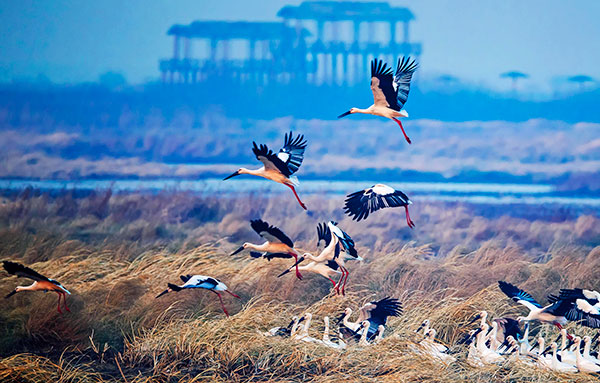Endangered storks flock to reserve in record numbers
Updated: 2015-10-30 07:43
By Zhou Huiying in Harbin and Chen Liang in Beijing(China Daily)
|
||||||||
|
A gathering of more than 700 Oriental storks was recorded at Naolihe National Nature Reserve in Heilongjiang province this year, the biggest aggregation in the reserve so far. Liu Liming / for China Daily |
During their regular patrol to monitor birds in autumn, rangers with Naolihe National Nature Reserve in Heilongjiang province recorded a gathering of more than 700 Oriental storks, an endangered water bird.
According to Birdlife International, a global partnership of organizations that strives to conserve birds, the population of the large white birds with black wing feathers and long black bills is estimated at 3,000.
"We had never seen such a big aggregation before in our reserve," said Cui Xingbo, a ranger there. "I haven't heard of any bigger aggregation recorded from other nature reserves in the province."
The ranger said that the stork is a regularly seen in the region's wetlands, migrating there in spring, breeding there in summer, and heading south in autumn.
They have often recorded flocks with 100 to 200 birds in past autumns in the reserve, which covers more than 160,000 hectares.
"It's certainly a good sign and proof of the reserve's better conservation in recent years," he said.
The reserve was established in July 2002, integrating three provincial reserves and a city reserve. The national reserve has provided a larger and better habitat to birds, Cui said.
"Before the national reserve was established, people farmed, harvested reeds and reclaimed farmland from wetlands," he said. "Now we have banned farming and have been trying to restore wetlands. Part of the reed bed where we saw the flock of Oriental storks was farmland before."
According to Cui, the reserve has 11 patrol stations and each has about 10 rangers responsible for regular patrols and monitoring.
Lei Jinyu, Yangtze species program manager of the World Wide Fund for Nature's Wuhan office, said the record reveals that the reserve can be considered as one of the most important stopover sites for Oriental storks in the world. "As far as I know, there was only one bigger count of about 900 Oriental storks recorded at Baidagang Reservoir in Tianjin," he said.
Mainly breeding in the Heilongjiang River and Ussuri River basins along the border of Russia and China, the storks winter in the lower Yangtze basin and southern China, Lei said. The storks have been considered a iconic species on the East Asia-Australia Flyway, a vast area stretching from the Arctic to Australia and New Zealand.
According to Cui, the rangers will keep an eye on the birds until they leave for the south.
Contact the writer at chen-liang@chinadaily.com.cn
Zhang Lei contributed to this story.

 Ryan nominated for speaker
Ryan nominated for speaker
 Top 10 news apps favored by smartphone users
Top 10 news apps favored by smartphone users
 Intimate Transgressions: More than just pain
Intimate Transgressions: More than just pain
 Want a butler at your home?
Want a butler at your home?
 Rescue operations in full swing as quake death toll hits 365
Rescue operations in full swing as quake death toll hits 365
 Merkel's visits to China aimed at forging 'special' ties
Merkel's visits to China aimed at forging 'special' ties
 Netherlands king enjoys local flavors of Yan'an
Netherlands king enjoys local flavors of Yan'an
 NBA MVP Curry scores 40 points, Warriors win opener
NBA MVP Curry scores 40 points, Warriors win opener
Most Viewed
Editor's Picks

|

|

|

|

|

|
Today's Top News
Tu first Chinese to win Nobel Prize in Medicine
Huntsman says Sino-US relationship needs common goals
Xi pledges $2 billion to help developing countries
Young people from US look forward to Xi's state visit: Survey
US to accept more refugees than planned
Li calls on State-owned firms to tap more global markets
Apple's iOS App Store suffers first major attack
Japan enacts new security laws to overturn postwar pacifism
US Weekly

|

|








